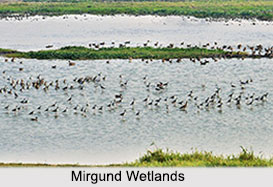 Mirgund Wetlands is the marshland area in Jammu and Kashmir. Mirgund Wetland is a shallow, freshwater wetland associated with reed-beds and riverine marshes.
Mirgund Wetlands is the marshland area in Jammu and Kashmir. Mirgund Wetland is a shallow, freshwater wetland associated with reed-beds and riverine marshes.
Location of Mirgund Wetlands
Mirgund Wetlands is located on the way of Baramulla District Highway in Jammu and Kashmir.
Geography of Mirgund Wetlands
Mirgund Wetlands covers 4 square kilometres of marsh land and it is the favourable place for ducks, teals and other local and migratory bird to breed in the summer months. Mirgund Wetlands is lying on the flood plain of the Jhelum River flood channel. This wetland is fed by the local runoff, the Sukhnag and the Ferozpur Nallas. The depth of the water generally varies between 0.1m and 0.5m.
Attraction in Mirgund Wetlands
Mirgund wetland in Kashmir Valley is a paradise for migratory birds and it is now one among the almost neglected wetlands of Jammu and Kashmir.
Flora and Fauna of Mirgund Wetlands
Mirgund Wetlands is decorated with different types of plants including some important and invaluable medicinal gems. So far no taxonomic exploration has been conducted in the area. Therefore it is futile to comment on the exact number of species growing in the area. Among all the plant species the dominant ones include Phragmites communis, Typha angustata, Carex, Cynodon dactylon, Polygonum, Nymphaea candicta, Nymphaea setllata, Potamogeton, Ceratophyllum, Sagittaria, Trapa, Poa species, many species of Salix and Populus, Equistem, Dryopteris, Satrinia, Marsilia quardifolia etc. An important medicinal plant namely Acorus Calamus locally called the Wai-mund grows over an estimated area of 10acres.Wai-mund is traditionally used in the treatment of digestive disorders, cough, cold and taken with a Kashmiri tea called the Kahwa. The data available regarding the wetland reveals that there are 179 species of phytoplanktons with predominance of the members of Chlorophycea. The whole wetland is surrounded by paddy fields, pastures, plantations of Salix and extensive reed-beds. In summers grasses and sedges are harvested. It also supports small fishery. An organic fuel locally called the Dembh is also dug out. The migratory water birds that come to this wetland include Cranes, Childonias hybrids, Duck, Geese Swans and Mallard among others. Cinnamon sparrows, the black and yellow grosbeak, black bulbuls and Monal Pheasants are also found. Other wildlife includes Jackal, the frog, the Toad and a variety of fish such as Cyprinus Carpio, Barbus Conchonius and Gambusia affins. The wetland is also rich in zooplankton diversity with predominant ones 39 protozoans, 17 rotiferans and 41 crustaceans.
Visiting information
It is just 16km away from Srinagar of Srinagar District of Jammu and Kashmir, on the left side of Gulmarg road sandwiched between Narbal, Check-i-Kawoosa, Mazhamz, Archandrahama, Arampur, Nupur and Mirgund villages.
Related Articles
Water Resources in India
Lakes of India
Jammu and Kashmir, Indian State
Srinagar,Jammu & Kashmir
Tourism In Srinagar, Jammu And Kashmir
Srinagar District, Jammu and Kashmir
Flora and Fauna of Jammu & Kashmir



















